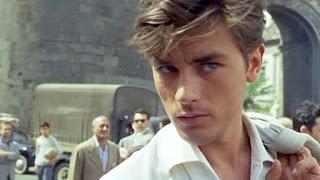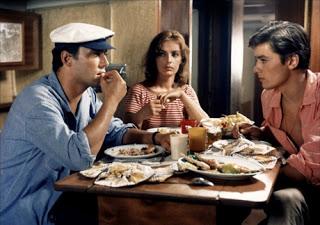
"I might not look it, but I've got lots of imagination."
Purple Noon (1960) adapts Patricia Highsmith's The Talented Mr. Ripley, with a French cast and crew shooting in Italy. The film offers escapism with an edge, a dark thriller ensconced in beautiful locales.Tom Ripley (Alain Delon) arrives in Italy to persuade Philippe Greenleaf (Maurice Ronet) to return home and manage his family business. Ripley enjoys carousing with his newfound friend, joining Philippe and his girlfriend Marge (Marie Laforet) on a yachting excursion until Philippe grows bored with him. Tom decides to kill Philippe and steal his identity, achieving both with remarkable ease.
Directed by Rene Clement, Purple Noon gorgeously renders its locations in Rome, Naples and elsewhere in Henri Decae's glorious photography. The inviting, languorous atmosphere (introduced by sprightly animated credits) suggests a light, globetrotting caper a la To Catch a Thief, with jet-setting crooks engaged in mild hijinks; only Nino Rota's score adds an undertow of menace. Then the movie explodes into violence and never looks back.
This works brilliantly, for Purple Noon is far darker than its surface suggests. Clement and screenwriter Paul Gegauff show harmless pranks between Tom and Philippe escalating into mutual hostility: Tom's cast in a lifeboat by Philippe, leaving him to drift in the scorching heat. His treatment of Tom ranges from amusement to contempt, viewing him as more freeloader than friend. Marge grows ensnared in their arguments, annoyed by Philippe's cruelty and infidelity; at one point, Philippe tosses her manuscript into the ocean.

In these segments, Clement's direction suggests Hitchcock less than The Day of the Jackal, which also followed a globetrotting criminal's meticulous preparations. Long scenes of preparation play out, with Tom transporting victims across town or honing his impersonation, menace buried within Italy's scenic beauty. The movie's slow, languorous atmosphere engrosses us in Tom's bleak exploits; we'd root for him except for the ruined lives he leaves in his wake.
Handsome, energetic and sly, Alain Delon possesses a devilish, sensual intensity that compels from the start; he hasn't yet hardened into the laconic killer of later films. Delon's playfulness transitions effortlessly into sociopathy, disarming suspicion with a grin or callow gesture. Maurice Ronet (a frequent Delon costar) exists mostly as a coarse foil; Marie Laforet gets a far meatier role. She has to be manipulated by Tom without seeming a dolt, opting for anguish over befuddlement.
Clement's sometimes criticized for softening Highsmith's original ending, but it's ambiguous enough to avoid disappointment. We're torn between rooting for Tom and wanting him dead, and the conclusion's ambivalent enough to satisfy both desires. Nothing speaks better to Purple Noon's brilliance.

